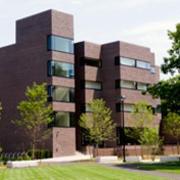
Rockefeller Hall at Harvard Divinity School has been awarded LEED Gold certification through the U.S. Green Building Council. LEED, which stands for Leadership in Energy and Environmental Design, is a rating system that assesses a building's potential impact to the environment and determines not only if a building is green, but how green it is.
After undergoing a 14-month renovation that ended in the summer of 2008, the nearly 40-year-old Rockefeller Hall is now one of Harvard's most energy efficient buildings. Each of the 49 LEED points applied for was accepted.
"Rockefeller Hall was modeled to have the most significant energy savings of any project at Harvard," said Nathan Gauthier, assistant director of Harvard's Office for Sustainability. "The building's energy efficiency achievement has helped convince others at the University that adopting an aggressive efficiency standard can be done in a cost-effective manner. The project has been so successful, the Office for Sustainability references it when promoting the benefits of well-managed integrated design and life cycle costing at Harvard."
The building's original design included 39 single-occupancy dormitory rooms with a kitchen on each floor. Now, "Rock" as it is known around HDS, holds staff offices, seminar rooms, and an updated lounge and refectory.
A key element of a sustainable building is how much of its new materials come from local sources. Roughly 80 percent of the materials that went into the refurbishment of Rockefeller are local, and 95 percent of old building materials were recycled, including a commercial kitchen that was sent to the Caribbean for reuse.
Rockefeller's gear-driven elevator is nearly 40 percent more efficient than typical hydraulic elevators. An energy recovery wheel saves energy by regulating heat and moisture exchange between indoor and outdoor air. High-voltage lighting in building service areas, such as the elevator, requires smaller wires and uses less energy. Room lights will turn off when occupants are not present. The sunny refectory has been fitted with CO2 sensors to control ventilation, and a white roof has helped reduce cooling costs. The entire HDS campus receives its electricity by way of purchased credits from Texas wind farms.
One of the most significant green measures taken at Rockefeller can be found in its method to conserve water. New features, such as waterless urinals and ultra-low flow sinks, have helped save 167,000 gallons of water per year. Outside, a state-of-the-art watering system on the HDS Campus Green looks at weather conditions by satellite and provides details on how much water is in the ground, and then adjusts the sprinklers to run based upon those data.
In 2008, Harvard President Drew Faust announced a University-wide goal to reduce campus greenhouse gas emissions by 30 percent by 2016.
"We have put a lot of effort in the last few months to working on HDS's greenhouse gas plan," says Ralph DeFlorio, HDS director of operations. "Each Harvard School had to recently submit a plan to the Office for Sustainability to meet the 30 percent reduction. It was a good process, and we were able to come up with a better understanding of where we were and what steps we need to take."
Energy usage at Rockefeller Hall has resulted in a reduction of 35 percent in greenhouse gas emissions compared to a standard building. Over the summer of 2009, HDS underwent energy audits, which, according to DeFlorio, allowed the operations team to identify 82 energy conservation measures.
"Most of the measures have a very quick payback—a couple years or less," explained DeFlorio. "Once the conservation measures are implemented, we will get pretty close to our goal and could potentially reach the University objective before 2016."
At Rockefeller, more efficient building operations have meant lower energy bills. The difference in energy costs from FY07 and FY09 was just over $45,000, with the biggest savings related to steam energy.
According to Harvard's Office for Sustainability, there are 22 LEED-certified projects on campus and another 44 that are LEED registered and pursuing certification.
LEED looks at occupant comfort, lighting, ergonomics, and fresh air. How much energy is the building using? How well insulated is it? What systems are in place to ensure energy is being conserved and used efficiently? In the original design phase, HDS looked at those issues and found that, when examining the paybacks for those standards, it made sense to have a LEED building.
"The LEED certification is a validation that we have taken a conscientious approach to sustainability," according to DeFlorio. "This would not have happened without people like Dean Graham and executive dean Julie Bisbee supporting sustainable initiatives and setting the tone for the School to move in that direction. We've had a lot of ongoing support, and the award ties to the effort."
—by Jonathan Beasley
